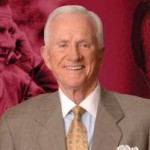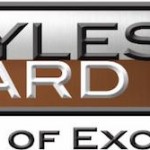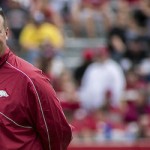
Right off the bat I could quibble with a couple of things in director Mike Looney’s documentary The Big Shootout.
Bobby Field, part of that legendary Hog defense of 1969 that allowed less than 10 points per game, was identified on the screen with his name and “Mon”.
“What is ‘Mon’?” I was asked by a couple of younger fans — I’m talking 30-somethings — who were also watching the debut of the documentary Thursday night at the Clinton Presidential Center’s Great Hall. I admit, I thought it too for a second, then wondered if it meant they were talking to Field about Monday of The Big Shootout week with Texas in 1969, the battle of No. 1 vs. No. 2 in Fayetteville.
But then it hit me that was to indicate his position, which was Monster Man. Like Free Safety and Linebacker and Defensive Tackle, Field was called the Monster Man in Charley Coffey’s 4-3 defense, the “monster” being what you’d know today as a strong safety. Forty-four years from now, we may wonder what a “Nickel Back” was, or why a football playing position was named after a bad pop music group of the early 21st century.
And, for my second quibble, I’d have to see the film again — and I plan to, several times— but I could have sworn the filmmakers, in trying to show a winding highway to Fayetteville to emphasize a point, used a shot of a road in the Rocky Mountains. Maybe “True Grit” can get away with putting Yell County in the Rockies, but c’mon — we’re talking Razorback football here. Yes, U.S. Highway 71 was a bitch to drive, probably more so in the cold and fog and snow flurries of Dec. 6, 1969, with a bus full of football players; but Fayetteville’s not Boulder, Colo. (and that’s too bad).
But, I digress.
That’s it, that’s all my quibbles for The Big Shootout documentary. This is kind of giving you the brief bad news, then the plentiful good news — and there is much to love in this documentary about a game that didn’t go Arkansas’ way.
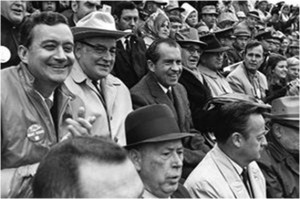
The Big Shootout is amazing and emotional and doesn’t always tread on what Hog fans might think is the same tired old ground. It’s like Terry Frei’s great book“Horns, Hogs and Nixon Coming” put on film for a couple of hours with even more interesting anecdotes and angles, some that seem part of a destiny no one could control.
There’s film from the sidelines from that game I’ve never seen before, such as Texas coach Darrell Royal talking over the crucial play with quarterback James Street, when the legendary coach rolled the dice with a fourth-down long pass to the tight end, Randy Peschel.
Every time I watch that replay of the fourth-and-3 pass from Street to Peschel, with the ball somehow finding the only place it could and still be completed, with the hands of Jerry Moore and Dennis Berner also there, it seems like Arkansas is that much closer, by the inch, to knocking it away. And of course, it still ends up complete, setting up Texas’ winning score with 3:50 to play.
I’d nearly forgotten that Arkansas was inside the Texas 40 and Bill Montgomery was intercepted for a second time that day at the Longhorns’ 21 on a pass that was 50-50 between the Hogs receiver, John Rees, and Texas’ Tom Campbell.
Same thing: one play here or there, and Arkansas is the winner of the Game of the Century. Would it have had the same impact nationally nearly a half-century later, I wonder?
Arkansas wasn’t the winner, yet 44 years later, it still remains maybe the most talked about game of the past century, not only because Texas won 15-14 on the last day of the regular season or because President Nixon attended and gave the Longhorns a national championship plaque; it’s because of everything else that surrounded and then followed the game.
Most everyone who was around then from Arkansas has quit getting teary-eyed over the result. But I dare you to not feel misty when the subject turns to Freddie Steinmark, one of the Texas safeties who played on a leg that just a few days later would be removed by surgeons because of cancer. Then you find out that Steinmark, who would be dead in 1971, visited Arkansas’ sideline on his crutches the next season, as Texas was thumping the Hogs 42-7 in a bad sequel to the Shootout, and in the most kind, sincere and classy fashion told Arkansas receiver Chuck Dicus, “It just wasn’t your day, Chuck.”
Just a few years after that, Texas cornerback Danny Lester, who became friends in the Philadelphia Eagles training camp with Arkansas defensive end Bruce James, was killed along with another friend in a car wreck driving to escape a gulf hurricane. James had planned on seeing Lester in New Orleans not long after they both left the Eagles. It still seems to haunt James.
The first interception Montgomery threw, the one that negated a likely fourth-down field goal that would have given Arkansas a likely insurmountable 17-8 midway through the fourth quarter, was something I didn’t expect to see the quarterback discuss.
Instead, director Looney was able to get much from Montgomery on the entire subject of the game, including the quote “It still haunts me,” about that interception.
James, Dicus, Montgomery and the Hogs probably didn’t think they’d become friends with their nemesis, but in 2004 — in spite of former coach Frank Broyles’ efforts to stop the gathering — the players had a reunion, with no coaches, in Northwest Arkansas before the Hogs’ game that season with Texas.
Whoever heard of players from two intense rivals such as Arkansas and Texas having a reunion 35 years after the fact? It was like old Civil War enemies coming together as friends.
And indeed, new friendships were struck up. Those led to meetings with other folks, such as when through Bruce James I met James Street for the first time, just a few years back.
Why, he’s not such a bad guy, I immediately thought, as the Hog players already had learned. In fact, he’s a hoot, a heckuva personality. I found out then, and the film also tells you, Arkansas could have signed him when they were recruiting Loyd Phillips’ brother, Terry Don, out of Longview, Texas.
But then history would have been changed. That’s not what fate had planned.
Instead, as the film seems to tell us, it was all meant to be. Everything came to pass as ABC’s Beano Cook had expected when he had ABC head honcho Roone Arledge in April move the game to Dec. 6 from the usual mid-October date. It came to pass just as the Arkansas Gazette’s Orville Henry wrote in August of that year, even the parts where Nixon attended and Billy Graham gave the invocation. How is that for prescience? People were meant to be touched by the lives of Freddie Steinmark and Danny Lester. Black students won their battle that day to have the Arkansas band no longer play “Dixie” after touchdowns. Protestors against the war found a perfect location, next to the UA administration building high on the hill northeast of the stadium, to put their peace sign and get Nixon to notice it. He had to have seen it, as surely then Congressman and future president George H.W. Bush saw it.
And that pass to Peschel, I finally realize, was meant to be caught.
I hope The Big Shootout helps older Hog fans that lived it, and the players who played it and suffered for several decades afterward, to have some healing. Broyles will never be healed; he claims that like all past games he put this one away when it was over and never watched the game film. He wasn’t able to attend the showing Thursday; he didn’t necessarily come out looking that great for the way he’s since handled the aftermath, particularly with his former players.
Texas’ Darrell Royal gave his last interview to the filmmakers. He was in the final days of illness and it was sad to see the once vibrant, smiling face of the Texas coach revealing his late-in-life suffering.
Montgomery said on film he still thinks about that one interception about once a week. Linebacker Mike Boschetti said last night he still thinks about this play or that play, 44 years later.
Yes, it was a game. Just a game. Yet it’s one that for many reasons that simply the result, The Big Shootout never goes away.
* * *
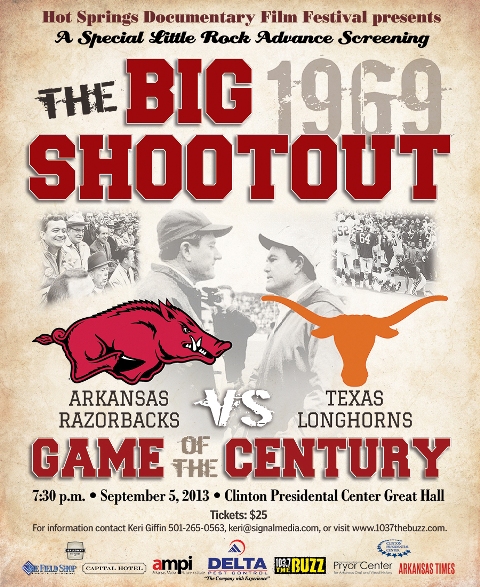 The good news for folks who want to see The Big Shootout, it will be a major part of the Hot Springs Documentary Film Festival, scheduled for Oct. 11-19 at the Arlington Hotel and other sites in the Spa City.
The good news for folks who want to see The Big Shootout, it will be a major part of the Hot Springs Documentary Film Festival, scheduled for Oct. 11-19 at the Arlington Hotel and other sites in the Spa City.
The film will be the headlining attraction on Friday, Oct. 18, at 7:30 p.m., with former Hog Bruce James attending.
The Big Shootout will be part of several sports-related films scheduled for the festival, including the new documentary on former Hog great turned millionaire Jim Lindsey and the recently released film on former UA quarterback Mitch Mustain, who is also scheduled to attend the festival during the screening of “The Identity Theft of Mitch Mustain.
Other films also include “Linsanity” about the Jeremy Lin sensation in the NBA, a film on native Arkansan Paul “Bear” Bryant, and much more. The full schedule should be completed and released within the next three weeks, according to festival director Courtney Pledger.
Then, in probably six months, the documentary will be available on DVD for purchase. Looney said the producers decided to buy the film instead of selling it to TV, which would have chopped it up to fit some time frame. Instead, if TV does show it, that won’t happen for at least a year.


